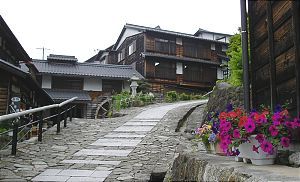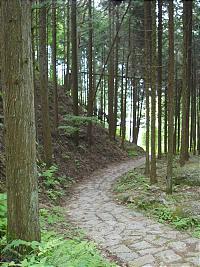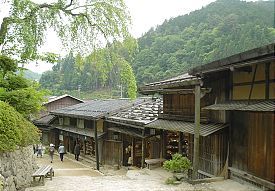Hey, have any of you ever been to the Kiso valley? It sounds very interesting. This is the kind of Japanese trip I want to experience. Not just going to some big city like Tokyo. Can anyone who has been there tell me about it?

MAGOME:
Magome is a beautifully preserved post town along the old Nakasendo, a former "highway" connecting Kyoto and Edo (Tokyo). Stretching for a few hundred meters along the main road, the town used to offer food and lodgings to travelers.
Today, Magome serves again travelers with restaurants, souvenir shops and minshuku and ryokan lodgings. An attractive walking course along the old Nakasendo connects Magome with Tsumago, another beautifully preserved post town.

NAGASENDO WALK:
The beautiful former post towns of Tsumago and Magome are connected with each other by an attractive walking trail that follows the old Nakasendo, a Edo Period highway from Kyoto to Edo.
The trail is about 8 kilometers long and can be covered in two to three hours. Partly nature trail, partly covered by original cobblestones and partly paved roads, the trail passes several small villages, waterfalls and historic structures.
A baggage forwarding service is available at either town's tourist office during summer.

TSUMAGO:
Tsumago is a beautifully preserved post town along the old Nakasendo, a former "highway" connecting Kyoto and Edo (Tokyo). Most of the town's buildings date from the Edo Period when they served as lodgings and restaurants for travelers.
Today, several buildings are open to the public including a museum which documents local history. Furthermore, a number of minshuku and ryokan once again serve travelers on the Nakasendo.
An attractive walking course along the old Nakasendo connects Tsumago with Magome, another beautifully preserved post town.
-------Info and pics from www.japan-guide.com
A couple of articles on the place.
Kiso Valley, the "Other" Japan
By Ron Bernthal
On a warm spring day, with the Kiso River rushing headlong down the valley, and the snowy peak of Mt. Ontake fading behind the morning haze, 80-year-old Yoshido Kuroda tends to his small garden plot of root vegetables and assorted fruit trees.
His house, a thatched-roof traditional country farmhouse, known as a gassho-zukuri, is more than 200 years old and has been in Mr. Kuroda's family for almost that long. Inside the house there are none of the amenities that we usually associate with Japanese culture – no computers or fancy electronic equipment, no digital clock radios or large-screen Sony televisions. Like many homes in rural Japan, there are few windows, the ceiling is covered with soot, and the air inside is cold and damp even as a warm sun shines outside. Although an oil furnace is now sometimes used in winter, Mr. Kuroda often heats coals in the central fireplace, which is built into the floor and called an ironi.
Here, near a town called Kiso-Fukoshima, in the fairly remote Kiso Valley, is where one goes to see the "other" Japan, where small traditional villages eke out an existence based on family agricultural gardens, wood gathering in the dense forests, and hosting tourists, mostly Japanese, in dozens of quaint ryokan (Japanese inns).
With the neon lights of Tokyo's Ginza district several hours to the east, and the popular shrines and tourist attractions of Kyoto several hours to the west, the quiet Kiso Valley has not yet caught the attention of American visitors, who tend to travel from one congested urban area to another on the shinkansen (bullet train). It is difficult to get a sense of the countryside, of the intimacy of small Japanese villages, by staring out the windows of these trains as they whiz by at 200 miles per hour.
The tiny villages in this valley, surrounded by surprisingly high mountains known as the Japanese Alps, are not widely publicized, at least to outsiders, and their isolated location and “protected” status as historic sites have made them seem more mythic than real. Although the 1998 Winter Olympics was held about two hours away, few foreign visitors to those games braved the narrow icy roads that would have lead them through the mountains to this region of Nagano-ken (prefecture)
During Japan’s Edo period, which began in 1600 and lasted until the mid-1800's, the Kiso Valley was traversed by the Nakasen-do Highway, an old post road which connected Edo (present-day Tokyo) with Kyoto. At the lower end of Japanese society at this time, farmers were subject to a severe system of rules which dictated in minutest detail their food, clothing and housing. Social mobility was blocked and social standing was determined by birth. In addition, it was during these years that Japan entered into a period of national seclusion (sakoku) when Japanese were forbidden to travel to or return from overseas, on penalty of death.
Because of this difficult political situation, the remote post road towns between Edo and Kyoto, while hosting a constant stream of travelers, remained stagnant in their growth and development. They were slow to change even during the Meiji Restoration period that followed, when western influence began to infiltrate Japanese culture.
It wasn’t until the 1960's, after Japan’s war-torn cities were rebuilt with ugly cement apartment buildings and sprawling industrial areas, that the Japanese government finally recognized these villages as architectural treasures, and laws were passed to preserve their original structures.
Today, these villages, especially Magome and Tsumago, are so well preserved that they feel like open-air museums. In fact, they are real communities, with about 500-1,000 people living in each village, many catering to the needs of day-tripping Japanese tourists and school groups who wander along the main “street” of each town, mesmerized by the abundance of machiya, traditional small row houses that front the street.
In both villages cars and buses are directed to parking lots some distance away, so the pedestrian-only “main streets” are free of the noise and pollution one finds in most Japanese towns. Government regulations forbid modern developments that may visually mar the scene, so TV antennas, telephone poles and neon signs are strictly forbidden.
Although souvenir shops, artfully installed within the traditional building facades, sell local crafts, there is little else to buy or do in these historic villages other than visiting the occasional small museum or cafe. In Tsumago visitors can spend some time at the Okuya Kyodokan Folk Museum, which is part of a magnificent house built like a castle. During the Edo period, the cutting of trees was strictly controlled, but in 1877, when these rules were lifted, the owner of the house rebuilt his residence using the local hinoki (cypress trees).
From Tsumago, to get to Magome, with its steep pedestrian-only “main street” and its beautiful view of the nearby mountains, visitors can drive (15 minutes), take the local bus or follow a three-hour walking path through the forest. Magome is especially charming, and a real Japanese experience would involve staying overnight at the Tajimaya Ryokan, a five-room guest house in the middle of the village.
Rooms are small and spare, with tatami mats, a small television and a low table for meals, which may include the local specialities of gohei-mochi (rice dumpling on a stick coated with nut sauce) and sansai (mountain greens). Like most ryokan in the area, male and female bathing rooms are provided, where guests can wash and then soak in wood tubs of very hot water.
Outside the village of Magome, a five-minute walk from the ryokan, is the splendor of rural Japan, with its plum, cherry, and peach trees, small family cultivated rice paddies, and hundreds of fresh water streams that tumble down from the mountains, creating the smooth, flat river rocks that compliment Japanese gardens.
Early evening is a wonderful time to stroll through these historic towns, with brightly colored lanterns hanging outside doorways and the lovely sound of the shakuhachi, a traditional wind instrument, emanating from open windows. Crickets sing from nearby woods, and the smells of miso and fire smoke commingle in the cool night air. With just a little imagination, you can even begin to feel like a 17th-century samurai, a tired Kiso warrior on the way home to bed.
If You Go. . .
Getting There: From Tokyo you can sign up with local motorcoach tours for a one or two-day excursion to the Kiso Valley region. Independent trips can be made via Japan Rail’s Chuo line that provides access from Tokyo to Nakatsugawa or Nagiso stations in Nagano-ken. One-way train fare on a limited express train is about $50 for the three-hour trip.
Weather: The Kiso Valley gets lots of snow during the winter, and can be quite hot and humid during July and August. With little central heating and few air conditioners available, keep these extremes in mind before planning overnight in accommodations anywhere in Japan. The best time to go is late spring or early fall, where 70-degree days, and 55-degree nights make for pleasant touring.
Language: Japanese is, of course, the official language, and it would be helpful to learn a few common phrases, especially “thank you” – domo arigato. Few Japanese in rural areas will speak English, and most menus and signs will be in Japanese. But the Japanese hospitality and willingness to help will overcome all language barriers. Bring a good phrase book with translations in Japanese letters. Railroad stations do have English translations on ticket windows and platform signs.
Eating There: Yes, food is expensive in Japan. Even a small portion of soba noodles or dumplings, miso soup or rice, with a beer or Coke at small restaurants (shokudo) will cost close to $1,150 yen ($10). But ryokans include two meals in their room prices, and supermarkets and small shops offer cups of dry noodles and other ready-to-eat snacks that can be cooked just with hot water. Yakitori restaurants (grilled chicken on skewers) are also inexpensive.
Let the samurai out of the cage in the Kiso Valley
By Mark Stahnke
Come on admit it. The reason why you came to Japan wasn’t because you were driven to help Japanese society move toward greater international understanding (like you said in the job interview), but rather because you saw all four parts of the made for television version of James Clavell’s Shogun and had this rampant fantasy about being a samurai. Don’t deny it. You wanted to sit cross legged on tatami mat floors in your yukata while old ladies brought you tea on their knees and commended gaijin-san on how strong he is. You wanted young maidens in silky robes to walk bare foot all over your back like you were tub of grapes, constantly commending gaijin-san on how muscular his thighs are. You wanted to run your mighty sword through people who pissed you off, wipe the blade on the curtains as you leave.
Well, that may have been the fantasy that got you over here but the reality is that you probably spend all your time in subways and bars and offices. The closest you ever got to traditional Japanese culture was probably that night you passed out in front of the ikebana school…remember that one? After six beers and two tequila shots you just couldn’t conjugate the verb ‘go home"’ to the taxi driver and the girl you were with had already skipped out of the bar with some guy who was only two chapters ahead of you in the Japanese for Busy People text book. What a night. We’ve all had them gaijin-san, but fear not. Keep that fantasy burning bright, because the Japan of James Clavell’s imagination can still be found…and it is only two hours from Nagoya.
Lying in the south-west of Nagano-ken along Route 19 between Matsumoto and Nagoya is the Kiso Valley. Most famously, this area is the home of the Nakasendo, an old post road that connected Kyoto and Tokyo in Edo times and which surely carried thousands of samurai on their journeys to people or places that, for no doubt honorable reasons, had to be killed or pillaged. The area has more relics from Japan’s past than you can point a rusty sword at, from well preserved villageslike Magome and Tsumago, to your ubiquitous pristine temple. What’s more, although it is still illegal there to run your mighty sword through people who piss you off, there are many minshuku and ryokan where, even if you wanted to, you just can’t stop those old ladies from bringing you more tea.
The best part of the Kiso experience though is that, once the euphoria of rediscovering that latent samurai in your soul has started to fade, you can happily return to the twentieth century and tackle some snowboarding, mountainbiking or hiking. Mount Ontake, the area’s resident volcano also ensures that there is plenty of thermal activity around for a long onsen after you have finished.



